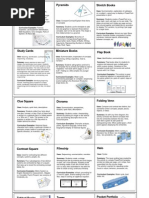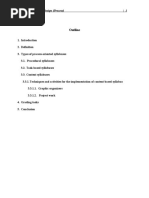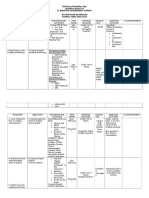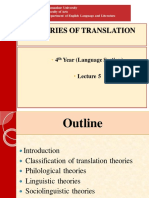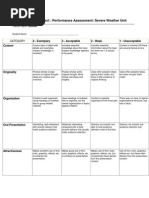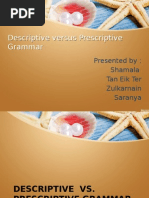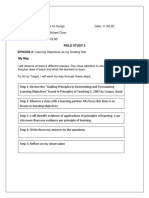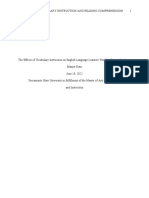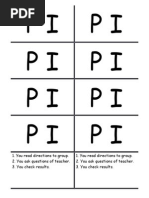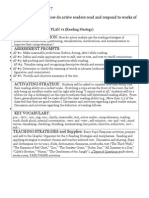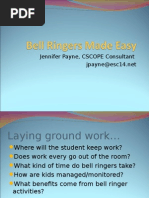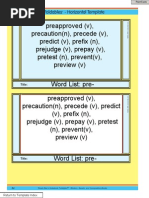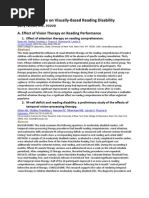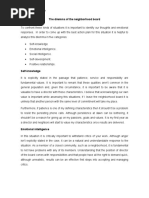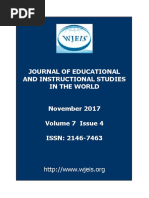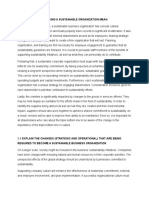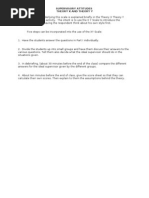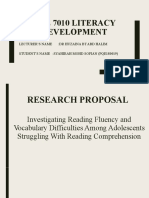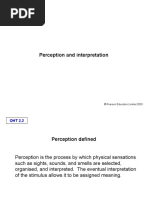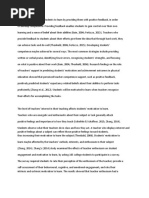Directed Reading Thinking Activity Strategy Checklist
Directed Reading Thinking Activity Strategy Checklist
Uploaded by
eva.bensonCopyright:
Available Formats
Directed Reading Thinking Activity Strategy Checklist
Directed Reading Thinking Activity Strategy Checklist
Uploaded by
eva.bensonCopyright
Available Formats
Share this document
Did you find this document useful?
Is this content inappropriate?
Copyright:
Available Formats
Directed Reading Thinking Activity Strategy Checklist
Directed Reading Thinking Activity Strategy Checklist
Uploaded by
eva.bensonCopyright:
Available Formats
Reading Strategy- Comprehension
Name of Strategy: DRTA Directed reading thinking Activity Age/Grade Level: K-6
Description of strategy: DR-TA is an instructional strategy that improves comprehension and Time Needed: 30-45 minutes
promotes active reading and critical thinking by having students predict, read, question, and
prove or disprove their prediction.
Use this strategy when a learner has one or more of these targets for growth:
-Needs to self-monitor to make meaning using background knowledge
-Needs to predict using background knowledge
-Needs to be able to scan materials in order to make predictions
-Needs to be able to set purposes for reading in order to confirm predictions from text
-Needs to view sense making rather than accurate word calling as primary goal of reading
Materials: (If a reproducible is needed please provide.)
Teacher selected text divided into appropriate segments.
DRTA guide (attached)
Procedure:
1. During planning, teacher divides the text into appropriate segments which can be single paragraphs or several pages, depending on
the content.
2. Direct student’s attention to title, pictures, headings, graphs, etc.
3. Following this, ask questions such as these which:
Activate Thought “What do you think?”
Agitate Thought “Why do you think so?”
Require Evidence “How can you prove it?”
References: References: Gillet, J. and Temple, C. (1982). Understanding reading problems. Boston: Little, Brown and Co. Moore, D., Readence, J., and
Rickelman, R. (1989). Prereading activities for content area reading and learning. Newark, DE: IRA. Stauffer, R. (1975). Directing the reading-thinking
process. New York: Harper & Row. http://www.coe.unt.edu/patterson/4870/strategies.htm#DRTA
M Garra, L O’Donnell 9/19/2008
4. Student reads the segment of the text silently to confirm predictions and during discussion, the text is used to confirm or disconfirm
predictions. Students are asked to cite the text that caused them to confirm or change a prediction.
6. Students are expected to use the context to figure out vocabulary which may be new or difficult. This vocabulary can be discussed
using predictive questions such as: What do you think this word means? Why do you think so?
7. The process is repeated until each segment of the text has been read.
Variations:
1. Can be used as a strategy with an individual, small or large group, narrative or expository texts. Use heterogeneous or
homogeneous groupings, use different leveled reading passages.
2. Teacher-developed reading guide with predictive open-ended questions and space for written conversation about each segment
with a peer or teacher.
3. Directed Listening-Thinking Activity (DL-TA) is the same procedure but the teacher reads the text aloud to the students, providing
opportunities to develop critical listening and thinking skills.
Monitoring and Charting: (Use the following questions to keep track of student growth…)
• Does the reader make spontaneous and reasonable predictions?
• Is the reader able to support the confirmation or disconfirmation of the prediction through the text?
• Is the reader able to talk about their own thinking process?
• Do predictions show awareness of story structure?
• Does the reader change and/or refine predictions when necessary?
• Does the reader effectively use context to analyze new words?
• Is the reader able to use illustrations to get information?
• Is the reader able to relocate specific information needed to confirm or disconfirm predictions?
• Does the reader use both stated and implied information?
References: References: Gillet, J. and Temple, C. (1982). Understanding reading problems. Boston: Little, Brown and Co. Moore, D., Readence, J., and
Rickelman, R. (1989). Prereading activities for content area reading and learning. Newark, DE: IRA. Stauffer, R. (1975). Directing the reading-thinking
process. New York: Harper & Row. http://www.coe.unt.edu/patterson/4870/strategies.htm#DRTA
M Garra, L O’Donnell 9/19/2008
You may wish to use the chart below to monitor progress over time:
DIRECTED READING THINKING ACTIVITY STRATEGY CHECKLIST
_______________________________________
SKILLS DATE
Makes spontaneous
predictions based on text
Supports predictions
through the text
Predictions show an
awareness of story structure
Changes and/or refines
predictions as needed
Effectively uses context to
analyze new words
Uses illustrations to get
information
Locates information to
confirm or revise
predictions
Uses explicit information
Uses implied information
+ Established 0 Not Evident - Emerging
References: References: Gillet, J. and Temple, C. (1982). Understanding reading problems. Boston: Little, Brown and Co. Moore, D., Readence, J., and
Rickelman, R. (1989). Prereading activities for content area reading and learning. Newark, DE: IRA. Stauffer, R. (1975). Directing the reading-thinking
process. New York: Harper & Row. http://www.coe.unt.edu/patterson/4870/strategies.htm#DRTA
M Garra, L O’Donnell 9/19/2008
DIRECTED READING THINKING ACTIVITY STRATEGY CHECKLIST
Name:__________________________________________
SKILLS DATE
Makes spontaneous predictions
based on text
Supports predictions through the
text
Predictions show an awareness of
story structure
Changes and/or refines
predictions as needed
Effectively uses context to analyze
new words
Uses illustrations to get
information
Locates information to confirm
or revise predictions
Uses explicit information
Uses implied information
+ Established 0 Not Evident - Emerging
DIRECTED READING THINKING ACTIVITY STRATEGY CHECKLIST
Name:__________________________________________
SKILLS DATE
Makes spontaneous predictions
based on text
Supports predictions through the
text
Predictions show an awareness of
story structure
Changes and/or refines
predictions as needed
Effectively uses context to analyze
new words
Uses illustrations to get
information
Locates information to confirm
or revise predictions
Uses explicit information
Uses implied information
+ Established 0 Not Evident - Emerging
You might also like
- Parker Et Al 2023 Chatgpt For Automated Writing Evaluation in Scholarly Writing InstructionDocument7 pagesParker Et Al 2023 Chatgpt For Automated Writing Evaluation in Scholarly Writing Instructioncvelizp0No ratings yet
- Poetry Lesson The Adventures of IsabelDocument5 pagesPoetry Lesson The Adventures of Isabeleva.benson100% (3)
- Chapter 5 Observing Learning and Teaching in The Second Language Classroom Natural and Instructional SettingsDocument16 pagesChapter 5 Observing Learning and Teaching in The Second Language Classroom Natural and Instructional SettingsI Gusti Agung HannytianandaNo ratings yet
- Seven Strategies To Teach Students Text Comprehension - Reading Topics A-Z - Reading RocketsDocument12 pagesSeven Strategies To Teach Students Text Comprehension - Reading Topics A-Z - Reading RocketsMary Child100% (1)
- Foldables Project TypesDocument2 pagesFoldables Project Typeseva.benson100% (3)
- The Relationship Between The Comprehension Level of Grade 12 Abm Students and Their Academic Performance in Fundamentals of Accounting and Business ManagementDocument4 pagesThe Relationship Between The Comprehension Level of Grade 12 Abm Students and Their Academic Performance in Fundamentals of Accounting and Business ManagementJerald carino100% (3)
- Instructional Design ProcessDocument1 pageInstructional Design ProcessMahyuddin Alghowry100% (3)
- GR 6 Making Connections Lessons 1-3 2Document7 pagesGR 6 Making Connections Lessons 1-3 2Sheila Marie De VeraNo ratings yet
- Field Study 2 Learning Episode 1: PRINCIPLES OF LEARNINGDocument9 pagesField Study 2 Learning Episode 1: PRINCIPLES OF LEARNINGMarvin Campaner-Cosep Gwa PoNo ratings yet
- Prejudice & BiasDocument32 pagesPrejudice & BiasJD GarciaNo ratings yet
- Making Connections Text To TextDocument2 pagesMaking Connections Text To Texteva.bensonNo ratings yet
- ELS 131 Language Policies and ProgramDocument11 pagesELS 131 Language Policies and ProgramJr RequitaNo ratings yet
- D. Nunan (1988), Syllabus DesignDocument83 pagesD. Nunan (1988), Syllabus Design곽도형No ratings yet
- Syllabus - Language Testing and AssessmentDocument5 pagesSyllabus - Language Testing and AssessmentComaythang5No ratings yet
- Inductive and Deductive InstructionDocument3 pagesInductive and Deductive InstructionTon TonNo ratings yet
- Directed Reading Thinking Activity (Drta) On Students' Reading ComprehensionDocument69 pagesDirected Reading Thinking Activity (Drta) On Students' Reading ComprehensionIfnu SyariffudinNo ratings yet
- Mycah Research ProposalDocument9 pagesMycah Research ProposalJessa Mae GalanidaNo ratings yet
- Task Based and Process SyllabusesDocument39 pagesTask Based and Process SyllabusesMak KingsengNo ratings yet
- Types of Syllabus DesignDocument11 pagesTypes of Syllabus Designhala khwatmiNo ratings yet
- GROUP 7 FAN Technique PVR by MEGILYN T. HOLMANDocument26 pagesGROUP 7 FAN Technique PVR by MEGILYN T. HOLMANMhel KilaNo ratings yet
- Educ 5Document42 pagesEduc 5kokomelonsi100% (1)
- Action Plan in English 2016 2017Document4 pagesAction Plan in English 2016 2017RhevD.DelosSantosNo ratings yet
- Pertusis 2Document21 pagesPertusis 2AbhishekNo ratings yet
- Framework For Whole School LiteracyDocument33 pagesFramework For Whole School Literacy3alliumcourtNo ratings yet
- Lgalvan@unicolombo - Edu.co: Fundación Universitaria UnicolomboDocument3 pagesLgalvan@unicolombo - Edu.co: Fundación Universitaria UnicolomboLuisa BlancoNo ratings yet
- ESP SyllabusDocument8 pagesESP SyllabusEva Nita GintingNo ratings yet
- Curriculum Involvement: Jiezel C. Del CastilloDocument57 pagesCurriculum Involvement: Jiezel C. Del CastilloJiezel CastorNo ratings yet
- Week 7 LP 1 Reading and WritingDocument4 pagesWeek 7 LP 1 Reading and WritingMA. DIOFEL LACAYANo ratings yet
- Theories of Translation: 4 Year (Language Section)Document14 pagesTheories of Translation: 4 Year (Language Section)Tuva EdisonNo ratings yet
- Introduction To Language TestingDocument28 pagesIntroduction To Language TestingAndhika FatriaNo ratings yet
- 2016 Engg7q2 PDFDocument80 pages2016 Engg7q2 PDFMartinez GizelleNo ratings yet
- Learning Activity 1 Documenting and Assessing Student ProgressDocument23 pagesLearning Activity 1 Documenting and Assessing Student ProgressLeriMarianoNo ratings yet
- PORTFOLIO II in Professional Education by NAMRAH MANGKABONG SATTARDocument91 pagesPORTFOLIO II in Professional Education by NAMRAH MANGKABONG SATTARCGMED SWM ZAMBOANGANo ratings yet
- Supplementary Skills To Enhance Language Skills of LearnersDocument12 pagesSupplementary Skills To Enhance Language Skills of LearnersAmiya Arnav100% (1)
- Classroom Management Plan-ElenitaDocument6 pagesClassroom Management Plan-ElenitaElenita PabellanNo ratings yet
- 1stobservation-2ndgrade-Yates 2Document7 pages1stobservation-2ndgrade-Yates 2api-463766485No ratings yet
- Chapter 2,3,4. (Language and Literacy Assessment)Document6 pagesChapter 2,3,4. (Language and Literacy Assessment)mike galang100% (1)
- Chapter2-ForeignandSecondLanguageAssessmentLiteracy-CoombeTroudi and AlHamlyDocument16 pagesChapter2-ForeignandSecondLanguageAssessmentLiteracy-CoombeTroudi and AlHamlyDEWI ARIANo ratings yet
- Principles of Speech DeliveryDocument3 pagesPrinciples of Speech DeliveryPatricia Mae Carrillo0% (5)
- Language Assessment Principles - WashbackDocument8 pagesLanguage Assessment Principles - WashbackRosmalia Kasan100% (1)
- Lesson PlanDocument5 pagesLesson PlanFadhilah Mohd Shaher100% (1)
- Dok For WritingDocument3 pagesDok For Writingapi-242128584No ratings yet
- Mistakes and FeedbackDocument18 pagesMistakes and FeedbackAlexandria ThomasNo ratings yet
- Rjade Imrad Edit.Document40 pagesRjade Imrad Edit.Rjade AbalayanNo ratings yet
- CLT HandoutDocument2 pagesCLT Handoutapi-298438495No ratings yet
- POST Reading StrategiesDocument8 pagesPOST Reading StrategiesMENDiolapNo ratings yet
- Rubric For Reflection PaperDocument2 pagesRubric For Reflection PaperJian ManuyagNo ratings yet
- Thematic Unit For Esl Listening and Speaking CourseDocument26 pagesThematic Unit For Esl Listening and Speaking Courseapi-296553705No ratings yet
- Field Study 6 Module Revised 2017-2018Document39 pagesField Study 6 Module Revised 2017-2018Dhingcoi Czc Allado AducalNo ratings yet
- Methods of Teaching Final HandoutDocument6 pagesMethods of Teaching Final HandoutAlbert Jerome Fontejon BabaylanNo ratings yet
- Persuasive Writing Session LPDocument4 pagesPersuasive Writing Session LPSarahKatherineNo ratings yet
- Bloom Question StemsDocument3 pagesBloom Question Stemsapi-266088524No ratings yet
- Teaching Large ClassesDocument11 pagesTeaching Large ClassesJayson Rey Matos GapeNo ratings yet
- Multimedia Project: Performance Assessment: Severe Weather UnitDocument2 pagesMultimedia Project: Performance Assessment: Severe Weather Unitapi-250772462No ratings yet
- 5syntactical SD (Galperin)Document31 pages5syntactical SD (Galperin)AvrilNo ratings yet
- Lle 7204 Teaching Speaking and Listening Skills To Adult LearnersDocument3 pagesLle 7204 Teaching Speaking and Listening Skills To Adult LearnersJu La LaiiNo ratings yet
- Descriptive Versus Prescriptive GrammarDocument7 pagesDescriptive Versus Prescriptive GrammarSai Sharvina ShriNo ratings yet
- Language AcquisitionDocument8 pagesLanguage AcquisitionYuri Paola Infante0% (1)
- Syllabus ESPDocument4 pagesSyllabus ESPJeane Dagatan100% (1)
- School Teachers TrainingDocument14 pagesSchool Teachers Trainingsana fatimaNo ratings yet
- Field Study 2 EPISODE 2: Learning Objectives As My Guiding Star My MapDocument4 pagesField Study 2 EPISODE 2: Learning Objectives As My Guiding Star My Mapmich aneNo ratings yet
- Final Action Research ProposalDocument13 pagesFinal Action Research Proposalapi-621535429No ratings yet
- StylisticsDocument24 pagesStylisticsLhyn Suarez PerezNo ratings yet
- Etymology Roots, Meanings, WordsDocument1 pageEtymology Roots, Meanings, Wordseva.bensonNo ratings yet
- Pipi Pipi Pipi PipiDocument8 pagesPipi Pipi Pipi Pipieva.bensonNo ratings yet
- Jigsaw Review of Chapter 1 Concepts Math 6thDocument6 pagesJigsaw Review of Chapter 1 Concepts Math 6theva.bensonNo ratings yet
- Core CHOMP 7th Grade Sample Pack2 PDFDocument18 pagesCore CHOMP 7th Grade Sample Pack2 PDFeva.benson67% (3)
- ELA Warmups3-5Document5 pagesELA Warmups3-5eva.bensonNo ratings yet
- LFS-SS - Reading StrategiesDocument4 pagesLFS-SS - Reading Strategieseva.bensonNo ratings yet
- Interactive Notebook and PortfoliosDocument4 pagesInteractive Notebook and Portfolioseva.bensonNo ratings yet
- Frayer Model StrategyDocument3 pagesFrayer Model Strategyeva.bensonNo ratings yet
- Journals 1 9 Weeks: 5 Minutes of Each ClassDocument33 pagesJournals 1 9 Weeks: 5 Minutes of Each Classeva.bensonNo ratings yet
- ELA TAKS Warm-Ups (Grades 6-11)Document5 pagesELA TAKS Warm-Ups (Grades 6-11)eva.bensonNo ratings yet
- Bellringers ELA: Huckleberry FinnDocument26 pagesBellringers ELA: Huckleberry Finneva.bensonNo ratings yet
- 6 Grade Pre/Ap-GT ELA Syllabus 2014-2015 Ms. Knight: First Nine WeeksDocument1 page6 Grade Pre/Ap-GT ELA Syllabus 2014-2015 Ms. Knight: First Nine Weekseva.bensonNo ratings yet
- Teachers Guide To Icarus and DaedalusDocument12 pagesTeachers Guide To Icarus and Daedaluseva.bensonNo ratings yet
- Bellringers ELA: Huckleberry FinnDocument26 pagesBellringers ELA: Huckleberry Finneva.bensonNo ratings yet
- 29-Bell Ringers Made EasyDocument35 pages29-Bell Ringers Made Easyeva.bensonNo ratings yet
- H - 2 Portable Word WallsDocument2 pagesH - 2 Portable Word Wallseva.bensonNo ratings yet
- Pocket Notebook Foldables® - PreDocument1 pagePocket Notebook Foldables® - Preeva.bensonNo ratings yet
- Word Wall ChartDocument3 pagesWord Wall Charteva.bensonNo ratings yet
- Note-Taking and SummarizingDocument1 pageNote-Taking and Summarizingeva.bensonNo ratings yet
- Visually Based Reading DisabilityDocument47 pagesVisually Based Reading Disabilityeva.bensonNo ratings yet
- Major Point Interview For ReadersDocument6 pagesMajor Point Interview For Readerseva.bensonNo ratings yet
- Strategies For Struggling Readers Sample PagesDocument9 pagesStrategies For Struggling Readers Sample Pageseva.benson0% (1)
- Lantoff, J. (2000) - Second Language Learning As A Mediated Process. Language Teaching 33 79-96.Document19 pagesLantoff, J. (2000) - Second Language Learning As A Mediated Process. Language Teaching 33 79-96.dygNo ratings yet
- Neighborhood Board DilemmaDocument3 pagesNeighborhood Board DilemmaEnrique UgaldeNo ratings yet
- Moyano, E. - (2016) Theme in English and SpanishDocument31 pagesMoyano, E. - (2016) Theme in English and SpanishGladys Cabezas PavezNo ratings yet
- Wjeis 2014.4Document152 pagesWjeis 2014.4nindy tryastutyNo ratings yet
- Chapter 8: Reading and MorphologyDocument1 pageChapter 8: Reading and MorphologyrodrigosanzanaNo ratings yet
- Task 2 - Discussion PanelDocument4 pagesTask 2 - Discussion Panelluis fernando RinconNo ratings yet
- Behavioral Interview QuestionsDocument3 pagesBehavioral Interview Questionsapi-26189934100% (5)
- Social Studies LessonsDocument10 pagesSocial Studies Lessonsapi-265501168No ratings yet
- Conflict and Problem SolvingDocument42 pagesConflict and Problem SolvingMambo JoshuaNo ratings yet
- Attitudes and Job Satisfaction: © 2007 Prentice Hall Inc. All Rights ReservedDocument15 pagesAttitudes and Job Satisfaction: © 2007 Prentice Hall Inc. All Rights ReservedElearnNo ratings yet
- 2 - Template-For-Tos-In-Ipt Filipino 6Document6 pages2 - Template-For-Tos-In-Ipt Filipino 6Mark Anthony LimNo ratings yet
- Futurology PresentationDocument8 pagesFuturology PresentationTawandamunashe DandaNo ratings yet
- PLM in Educ 12Document9 pagesPLM in Educ 12LORAINE LACERNA GAMMADNo ratings yet
- Business Sustainable PracticeDocument6 pagesBusiness Sustainable PracticeZahira ZafarullahNo ratings yet
- HCIDocument2 pagesHCIlove1990jainNo ratings yet
- A Lesson PlanDocument2 pagesA Lesson PlanMariel Jeanne SerasNo ratings yet
- Explain One Study of Reconstructive Memory.Document1 pageExplain One Study of Reconstructive Memory.Kate ForrestNo ratings yet
- 4 - Supervisory AttitudesDocument6 pages4 - Supervisory AttitudesIshu LakhaniNo ratings yet
- Effective Note Taking MS 04.09.2017 PDFDocument44 pagesEffective Note Taking MS 04.09.2017 PDFSinta Fauziah UlfahNo ratings yet
- Approved Analytic Rubric (Story & Report) - 26.07.2018Document4 pagesApproved Analytic Rubric (Story & Report) - 26.07.2018Trini BossNo ratings yet
- Practical Approaches To Behaviour Management in The Classroom A Handbook For Classroom Teachers in Primary Schools Copia (Arrastrado) 14Document1 pagePractical Approaches To Behaviour Management in The Classroom A Handbook For Classroom Teachers in Primary Schools Copia (Arrastrado) 14mitilene79No ratings yet
- Pqe 7010 Literacy DevelopmentDocument17 pagesPqe 7010 Literacy DevelopmentviniNo ratings yet
- Mse Alcohol DependenceDocument4 pagesMse Alcohol DependenceFlavouring vlogs100% (2)
- Improving Speaking Skills in English ThroughDocument28 pagesImproving Speaking Skills in English ThroughEdz SoretsellaB100% (1)
- Sociolinguistics Mid Term Course.Document34 pagesSociolinguistics Mid Term Course.Chishmish DollNo ratings yet
- Perception and Interpretation: © Pearson Education Limited 2003Document12 pagesPerception and Interpretation: © Pearson Education Limited 2003Pramod SharmaNo ratings yet
- Teachers motiva-WPS OfficeDocument4 pagesTeachers motiva-WPS OfficeYvonne Laidy ReyesNo ratings yet
- Core Principles of Waldorf Education: An Introduction and First DiscourseDocument3 pagesCore Principles of Waldorf Education: An Introduction and First DiscourseAivee ManahanNo ratings yet




